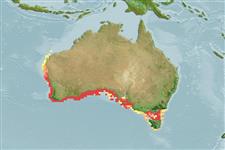>
Perciformes/Scorpaenoidei (Scorpionfishes) >
Pataecidae (Australian prowfishes)
Etymology: Neopataecus: Greek, neos = new + Pataeco, adwarf like Phoenician god. Refers to the likeness of this species to the image of gods on the bows of ancient sailing vessels (Ref. 45335).
Eponymy: Frederick George Waterhouse (1815–1898) was an English naturalist who made important contributions to the study of Australian fauna and flora. [...] (Ref. 128868), visit book page.
More on author: Castelnau.
Environment: milieu / climate zone / depth range / distribution range
Écologie
marin démersal. Temperate
Eastern Indian Ocean: endemic to Australia (Ref. 7300): South Australia.
Taille / Poids / Âge
Maturity: Lm ? range ? - ? cm
Max length : 22.0 cm TL mâle / non sexé; (Ref. )
Found on the continental shelf. Benthic (Ref. 75154). Max length from Fishes of Australia website: http://fishesofaustralia.net.au/home/species/2173.
Life cycle and mating behavior
Maturité | Reproduction | Frai | Œufs | Fécondité | Larves
Paxton, J.R., D.F. Hoese, G.R. Allen and J.E. Hanley, 1989. Pisces. Petromyzontidae to Carangidae. Zoological Catalogue of Australia, Vol. 7. Australian Government Publishing Service, Canberra, 665 p. (Ref. 7300)
Statut dans la liste rouge de l'IUCN (Ref. 130435: Version 2024-1)
Menace pour l'homme
Harmless
Utilisations par l'homme
Outils
Articles particuliers
Télécharger en XML
Sources Internet
Estimates based on models
Preferred temperature (Ref.
123201): 15.1 - 20.6, mean 16.9 °C (based on 90 cells).
Phylogenetic diversity index (Ref.
82804): PD
50 = 1.1250 [Uniqueness, from 0.5 = low to 2.0 = high].
Bayesian length-weight: a=0.00389 (0.00180 - 0.00842), b=3.12 (2.94 - 3.30), in cm total length, based on all LWR estimates for this body shape (Ref.
93245).
Niveau trophique (Ref.
69278): 3.6 ±0.4 se; based on size and trophs of closest relatives
Fishing Vulnerability (Ref.
59153): Low vulnerability (12 of 100).
